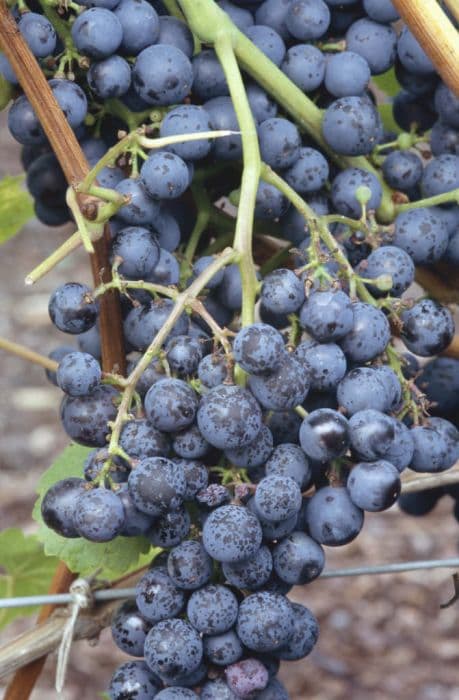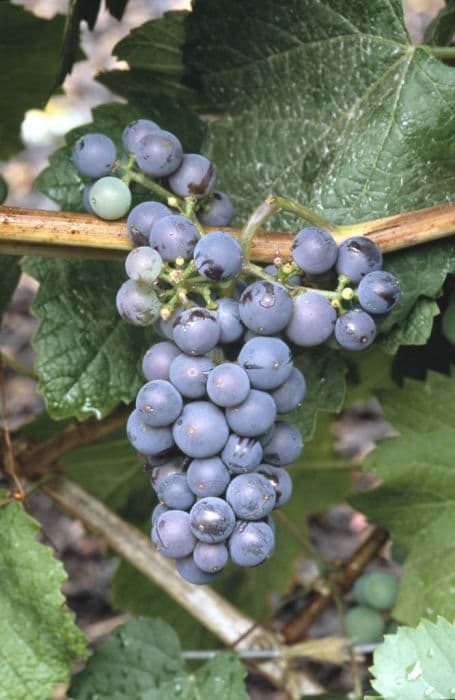Regent Grape Vitis 'Regent' (PBR) (O/b)

ABOUT
'Regent' is a variety of grapevine that is popular among gardeners and vineyard owners for its ornamental value and its ability to produce high-quality grapes. The plant boasts a lush, climbing growth habit, typically requiring a supporting structure such as a trellis or fence to which it can cling with its tendrils. The leaves of 'Regent' grapevine are broad and deeply lobed, exhibiting a rich green hue that turns to vibrant shades of red and purple in the fall, making it an attractive addition to the landscape throughout the seasons. As the seasons change, 'Regent' grapevine produces clusters of small, delicate flowers that are generally inconspicuous, yet they play a crucial role in grape development. Following flowering, the plant develops bunches of grapes that start as tiny green berries and mature into larger, round fruits. The grapes themselves are usually a dark blue to black color when ripe, often with a waxy bloom or coating that gives them a frosted appearance. The fruits are known for their sweet flavor and are used both for table consumption and winemaking, being highly valued for their disease resistance and adaptability to various climates.
About this plant
 Names
NamesFamily
Vitaceae
Synonyms
Regent Grape
Common names
Vitis 'Regent' (PBR) (O/b).
 Toxicity
ToxicityTo humans
The plant commonly known as Regent grape is not known to be toxic to humans when its fruits are consumed in normal quantities as they are commonly used for grape production and winemaking. However, consuming large amounts of the leaves or other plant parts may lead to stomach upset or other gastrointestinal symptoms as with many plants not typically meant for consumption.
To pets
Regent grape can be toxic to pets, especially dogs and cats, if they ingest the grapes or raisins that come from the plant. Symptoms of grape or raisin poisoning in pets may include vomiting, lethargy, abdominal pain, dehydration, and in severe cases can lead to kidney failure. It is important to keep grapes and raisins away from pets and seek veterinary attention if ingestion occurs.
 Characteristics
CharacteristicsLife cycle
Perennials
Foliage type
Deciduous
Color of leaves
Green
Flower color
Greenish-yellow
Height
4-6 feet (1.2-1.8 meters)
Spread
8-10 feet (2.4-3 meters)
Plant type
Climber
Hardiness zones
5
Native area
Europe
Benefits
 General Benefits
General Benefits- Disease Resistance: Resistant to common grape diseases like powdery mildew and downy mildew, reducing the need for chemical treatments.
- Frost Hardy: Capable of withstanding lower temperatures, making it suitable for cooler climates where other grape varieties may not thrive.
- Good for Winemaking: Produces high-quality grapes that are suitable for making red wine with good color, flavor, and tannin structure.
- Pollinator-Friendly: Attracts bees and other pollinators, which are essential for the pollination of many other plants in the garden.
- Decorative: As an ornamental vine, it provides aesthetic value with its lush foliage and attractive grapes.
- Versatility: Can be grown in a variety of settings including vineyards, gardens, and as a decorative plant over arbors or trellises.
- Low Maintenance: Once established, it requires minimal care apart from pruning, which makes it a convenient choice for gardeners of all skill levels.
- Fast-Growing: A relatively fast grower, which means it can quickly cover structures or fill in garden areas, providing shade and privacy.
- Edible Fruit: Produces edible grapes that can be enjoyed fresh, in cooking, or for making homemade wines or juices.
 Medical Properties
Medical PropertiesThis plant is not used for medical purposes.
 Air-purifying Qualities
Air-purifying QualitiesThis plant is not specifically known for air purifying qualities.
 Other Uses
Other Uses- Vitis 'Regent' grapevines can be trained to grow over arbors and pergolas, creating a natural shade structure and a picturesque garden feature.
- The leaves of the grapevine can be used for culinary purposes, such as in the preparation of dolmas, where they are stuffed with a filling and cooked.
- The flexible, woody vines can be woven into wreaths or other decorative items, especially after pruning the plant in the dormant season.
- Growing these vines on trellises or fences can be implemented as a privacy screen, providing a green barrier between different areas of a garden or property.
- The grape pips and skins, byproducts of wine production, can be composted or used to produce grapeseed oil which is used in gourmet cooking and skincare products.
- The wood from older grapevine branches can be repurposed into crafts, such as picture frames, furniture, or carved decorations.
- Small cuttings from the grapevine can be used to propagate new plants, encouraging the spread of this variety in home gardens or vineyards.
- When dried, the tendrils and smaller branches of Vitis 'Regent' can be used as kindling or incorporated into fire starters for outdoor pits or indoor fireplaces.
- The vibrant colors of grapevines in autumn can be used by landscape designers to add seasonal interest to gardens and parks.
- Used as a natural dye, the deeply pigmented grapes of Vitis 'Regent' can color fabrics and yarns in shades of blue, purple, or gray.
Interesting Facts
 Feng Shui
Feng ShuiThe Grapevine is not used in Feng Shui practice.
 Zodiac Sign Compitability
Zodiac Sign CompitabilityThe Grapevine is not used in astrology practice.
 Plant Symbolism
Plant Symbolism- Fertility: Vines, including grapevines like the Regent, traditionally symbolize growth and fertility due to their prolific nature and the abundant fruit they produce.
- Abundance: The grape clusters of the Regent grapevine represent plenty and generosity, as grapes have been a staple of abundance in many cultures, particularly in winemaking.
- Vitality: Because grapevines are vigorous and can live for many years, they are often associated with vitality and robust health.
- Transformation: The process of vines turning sunlight into energy, and grapes into wine, signifies transformation and the idea of change leading to beneficial outcomes.
- Prosperity: The grapevine, being an economic crop, especially in regions famed for viticulture, symbolizes prosperity and success.
- Dionysian Pleasure: In ancient Greco-Roman culture, the grape was associated with Dionysus/Bacchus, the god of wine, and therefore symbolizes pleasure, festivity, and indulgence.
 Water
WaterThe Regent grapevine should be watered deeply and infrequently to encourage strong root systems, which is especially important during the first few years after planting. It is generally recommended to provide about 1 inch of water per week, whether through rainfall or manual watering. During the growing season, increase the amount slightly to support fruit development. In terms of volume, this translates to approximately 0.623 gallons per square foot per week. Always check the soil moisture before watering to avoid overwatering; the soil should be moist but not waterlogged.
 Light
LightRegent grapevines thrive in full sunlight, so they should be planted in a spot where they receive at least six to eight hours of direct sun daily. The optimal lighting condition is unfiltered, direct sun exposure throughout the day, as this helps the plant to produce the energy it needs for growth and fruiting.
 Temperature
TemperatureThe Regent grapevine performs well in a temperate climate with ideal growing temperatures ranging between 60°F and 85°F. It can survive winter temperatures as low as 20°F; however, it needs protection from frost, especially during early growth stages. The vine is hardy and can tolerate seasonal temperature fluctuations, but it’s important to avoid extreme cold which can damage the plant or reduce fruit set.
 Pruning
PruningPruning the Regent grapevine is crucial for maintaining the health of the plant, controlling its growth, and ensuring a good harvest. Prune annually during the dormant season, typically in late winter before the buds swell, removing old wood and shaping the plant. Proper pruning includes thinning out crowded areas to allow sunlight to reach the fruits and improve air circulation, which reduces disease burden.
 Cleaning
CleaningNot needed
 Soil
SoilThe Regent grapevine prefers well-drained soil with a pH between 5.5 and 6.5. A good soil mix would consist of loamy soil amended with organic matter such as compost to ensure fertility and proper drainage. Regular mulching will help maintain an even soil temperature and moisture level.
 Repotting
RepottingThe Regent grapevine, being a robust outdoor plant, does not typically require frequent repotting. Young plants should be repotted every 2 to 3 years to encourage growth. Mature grapevines are usually planted in the ground and thus do not require repotting.
 Humidity & Misting
Humidity & MistingThe Regent grapevine is adaptable to a variety of outdoor conditions and does not require specific humidity levels. Being a vine cultivated primarily outdoors, it thrives in the ambient humidity of its natural environment which typically ranges from moderate to high.
 Suitable locations
Suitable locationsIndoor
Ensure full sun, support structure, and good air circulation for the grapevine.
Outdoor
Plant in full sun, use sturdy trellis, well-drained soil, and prune annually.
Hardiness zone
5-9 USDA
 Life cycle
Life cycleVitis 'Regent', commonly known as the Regent grapevine, begins its life cycle with seed germination, though cultivated grapevines are typically propagated via cuttings. After root establishment, the plant enters a vegetative stage characterized by the growth of shoots, leaves, and tendrils. During spring and early summer, flowering occurs, followed by pollination and fruit set, leading to the development of grape clusters. These grapes undergo veraison, where they change color and increase in sugar content as they mature. Upon reaching full ripeness, the grapes are harvested, which usually happens in late summer or fall depending on the climate. After harvesting, the vine enters dormancy over winter, conserving energy to begin the cycle anew in the spring.
 Propogation
PropogationPropogation time
Early summer
The Vitis 'Regent', commonly known as 'Regent' grapevine, is often propagated by hardwood cuttings, a method most popular due to its simplicity and effectiveness. This process is typically carried out in late winter when the vine is dormant, ensuring the best chance for rooting success before the spring growth begins. In this method, cuttings of about 12 to 18 inches (30 to 45 centimeters) long are taken from healthy, mature canes from the previous season’s growth. Each cutting should include at least two to three nodes, with the lower cut made just below a node and the upper cut made about an inch (2.54 centimeters) above a node. The cuttings are then planted directly in the ground or in pots with the lower two-thirds of each cutting buried in a well-draining soil mix. It’s vital to maintain consistent moisture and protect the cuttings from extreme temperatures as they develop roots and shoots.









